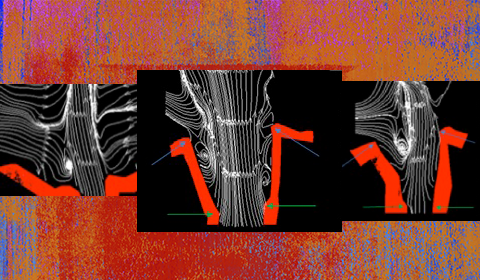
Noted Laryngologist Teams with Aerospace Engineer to Study Vortices, Acoustics, and Vibration in Vocal Fold Asymmetry
NIH-funded research1 is first to combine experimental and computational models
Sid Khosla, MD, Associate Professor of Otolaryngology at the UC Health Performance and Professional Voice Center, along with Liran Oren, PhD, Assistant Professor in Otolaryngology, have collaborated with Ephraim Gutmark, PhD, Professor of Aerospace Engineering at UC, to conduct a research study to characterize the effects of vortices and tissue elasticity on vocal fold vibration and acoustics in voice disorders.2 Khosla sees a clear clinical connection between this research and the treatment of vocal cord paralysis and other voice disorders.
The study used an advanced laser imaging technique that is common in aerospace engineering to measure airflow, particle image velocimetry (PIV), and discovered that small vortices, or areas of rotational motion, are formed between the vocal folds.2 The study’s findings support the hypothesis that vortex strength weakened when investigators simulated a voice disorder, and suggest that treatments with the most positive voice outcomes will be those that most effectively restore specific vortices.2
Khosla discusses the clinical applications of this research, specifically in terms of treating vocal paralysis. Currently, there are two surgeries that are routinely and interchangeably performed; because vocal cord paralysis can have so many presentations, it has been difficult to conduct an effective trial demonstrating differences between the two procedures. This current research, however, addresses that issue and shows that the stronger the vortex is in the vocal folds during closing, the greater the glottal efficiency, which translates to stronger vocal volume and lower levels of vocal fatigue.
Khosla states, “In the lab, we have seen that glottal efficiency is dependent on the vortices, and that for different operations, the glottal efficiency will be affected in a variety of ways.” In short, this research can impact the type of surgery clinicians perform on specific patients, in the hope that this will lead to improved outcomes.
The current study is a natural outcropping of work Khosla and Gutmark do in their laboratory, where they study aerodynamics and airflow in the upper airway and larynx in an effort to gain a better understanding of the mechanics of the human voice. This interdisciplinary, collaborative approach to voice research draws on the expertise of aerospace engineers, laryngologists, voice scientists, and even singers to advance this understanding. As Kholsa states, “We’re not the only ones in the country doing collaborative research – there are a few other centers that are, and I believe that’s the best way to approach these problems. I think getting as many perspectives as possible is healthy, and that’s certainly the trend.”
Measured vortices in a coronal cross section in the glottis while it is divergent as a function of subglottal pressure.
Pictured from left: Low Subglottal Pressure to High Subglottal Pressure
References:
1. 2009-2015 NIH R01 DC009435. “The relationship between vortices, acoustics, and vibration in vocal asymmetries”. Sid Khosla PI.
2. Oren L. Jet engine know-how helps voice studies take off. Waves. October 2014;30-32.
 Sid M. Khosla, MD
Sid M. Khosla, MD
Associate Professor
Director, UC Health Professional Voice Center
Director, UC Center for Laryngeal Biomechanics and Reconstruction
Dept. of Otolaryngology/Head & Neck Surgery
University of Cincinnati School of Medicine
Medical School: Bowman School of Medicine
513-558-1890
khoslasm@ucmail.uc.edu




